
Code_Aster
®
Version
5.0
Titrate:
Method multifrontale
Date:
26/02/01
Author (S):
C. ROSE
Key:
R6.02.02-B
Page:
1/18
Manual of Reference
R6.06 booklet: Direct methods
HI-75/01/001/A
Organization (S):
EDF/MTI/MN
Manual of Reference
R6.02 booklet: Direct methods
Document: R6.02.02
Method multifrontale
Summary:
The method multifrontale is a direct method particularly adapted to the resolution of the systems
linear whose matrix is hollow. This method includes a preliminary phase of renumerotation
intended to minimize the filling of the matrix during factorization.
This phase also makes it possible to gather the variables in “super-variables” or “super-nodes”. Factorization,
as for it, is carried out in the form of a continuation of elimination of super-nodes, in full matrices.
These full matrices allow the use of routines optimized like the BLAS, which obtain them
better performances on vectorial or scalar machines.
Having the factorized matrix, each resolution of system will require nothing any more but one
“gone up descent/” inexpensive.

Code_Aster
®
Version
5.0
Titrate:
Method multifrontale
Date:
26/02/01
Author (S):
C. ROSE
Key:
R6.02.02-B
Page:
2/18
Manual of Reference
R6.06 booklet: Direct methods
HI-75/01/001/A
Contents
1 Description of the method ..................................................................................................................... 3
1.1 Method LDLT for the full matrices ........................................................................................ 3
1.2 Hollow matrix and filling ........................................................................................................ 6
1.3 Method multifrontale ...................................................................................................................... 7
1.4 Descent - Increase ................................................................................................................... 13
2 Establishment and use in Code_Aster ..................................................................................... 14
3 Bibliography ........................................................................................................................................ 16
Appendix 1 Reference material of the method “Approximate Minimum dismantles” ................... 17
Appendix 2 Reference material Mongrel ......................................................................................... 17

Code_Aster
®
Version
5.0
Titrate:
Method multifrontale
Date:
26/02/01
Author (S):
C. ROSE
Key:
R6.02.02-B
Page:
3/18
Manual of Reference
R6.06 booklet: Direct methods
HI-75/01/001/A
1
Description of the method
The method multifrontale is a direct method of resolution of linear systems, which is
particularly adapted to the systems having a hollow matrix. It factorizes matrices
symmetrical or not, not necessarily definite positive. In the most general case, the method
multifrontale calls upon the method of Gauss with search for pivots.
The method established in Code_Aster is limited to the symmetrical matrices, and uses the algorithm
known as “
LDL
T
“, without search for pivot.
The resolution of a linear system is carried out in three stages:
·
renumerotation of the unknown factors,
·
factorization of the matrix,
·
gone up descent/.
If several linear systems, of the same matrix, are to be solved, only them
gone up descents/are to be carried out. The same if several of the same matrices structure are with
to factorize, the renumerotation of the unknown factors will not be to remake. This preliminary phase, which
the performance of factorization will ensure, has a considerable cost, however its relative weight (in
calculating time), decreases with the size of the matrices to factorize.
We will follow the following plan:
1) presentation of the method
LDL
T
conventional adapted to the full matrices. Concept
of elimination,
2) extension of the method to the hollow matrices, concept of filling,
3) presentation of the multi-frontal method.
1.1
Method LDLT for the full matrices
That is to say
With
, an invertible matrix, one knows that there is a lower triangular matrix
L
with diagonal
unit and a higher triangular matrix
U
, such as
With
L U
=
. The command of these matrices will be
N
.
If
With
is symmetrical, this decomposition can be written:
With
LDL
=
T
,
éq 1.1-1
where
D
is a diagonal matrix and
L
T
the matrix transposed of
L
, with diagonal unit.
Are
()
[]
I J
N
,
,
1
2
; from [éq 1.1-1] one deduces the expression from the coefficients from
L
and
D
. Indeed one
can write:
With
L D L
ij
K
N
L
N
ik
kl
lj
T
=
=
=
1
1
éq 1.1-2
L
being triangular lower than diagonal unit, and
D
diagonal, [éq 1.1-2] becomes:
()
With
L L
D
ij
K
I J
ik
jk
kk
=
=
min,
1
éq 1.1-3

Code_Aster
®
Version
5.0
Titrate:
Method multifrontale
Date:
26/02/01
Author (S):
C. ROSE
Key:
R6.02.02-B
Page:
4/18
Manual of Reference
R6.06 booklet: Direct methods
HI-75/01/001/A
There is to calculate the coefficients in many ways of
L
and
D
from [éq 1.1-3]. We go
to see the method called “by line” used usually in Code_Aster, and the method “by column”
used in the method multifrontale.
Method by line
Lines of
L
and
D
the ones after the others are calculated jointly. Let us suppose these lines
known until the command
(
)
I
-
1
, and also let us suppose that the coefficients of the line
I
are known
until the command
J
-
1
; [éq 1.1-3] is written, with
J I
<
:
With
L L
D
L D L
ij
K
J
ik
jk
kk
ij
jj
jj
=
+
=
-
1
1
éq 1.1-4
One has as follows:
L
With
L L
D
D
ij
ij
K
J
ik
jk
kk
jj
=
-
=
-
1
1
éq 1.1-5
and in a similar way:
D
With
L L D
II
II
K
I
ik
ik
kk
=
-
=
-
1
1
éq 1.1-6
With this method, each coefficient is calculated in only once (operation [éq 1.1-5]), while going
to seek the coefficients previously calculated, and by making the scalar product of
(
)
L
jk
K
J
,
=
-
1
1
and
(
)
T
K
K
J
,
=
-
1
1
, with
T
L D
K
ik
kk
=
.
This algorithm is illustrated by [Figure 1.1-a].
J
I
D
jj
J
I
(In gray and hatched, terms necessary
with the calculation of L
ij
)
L
ij
Appear 1.1-a
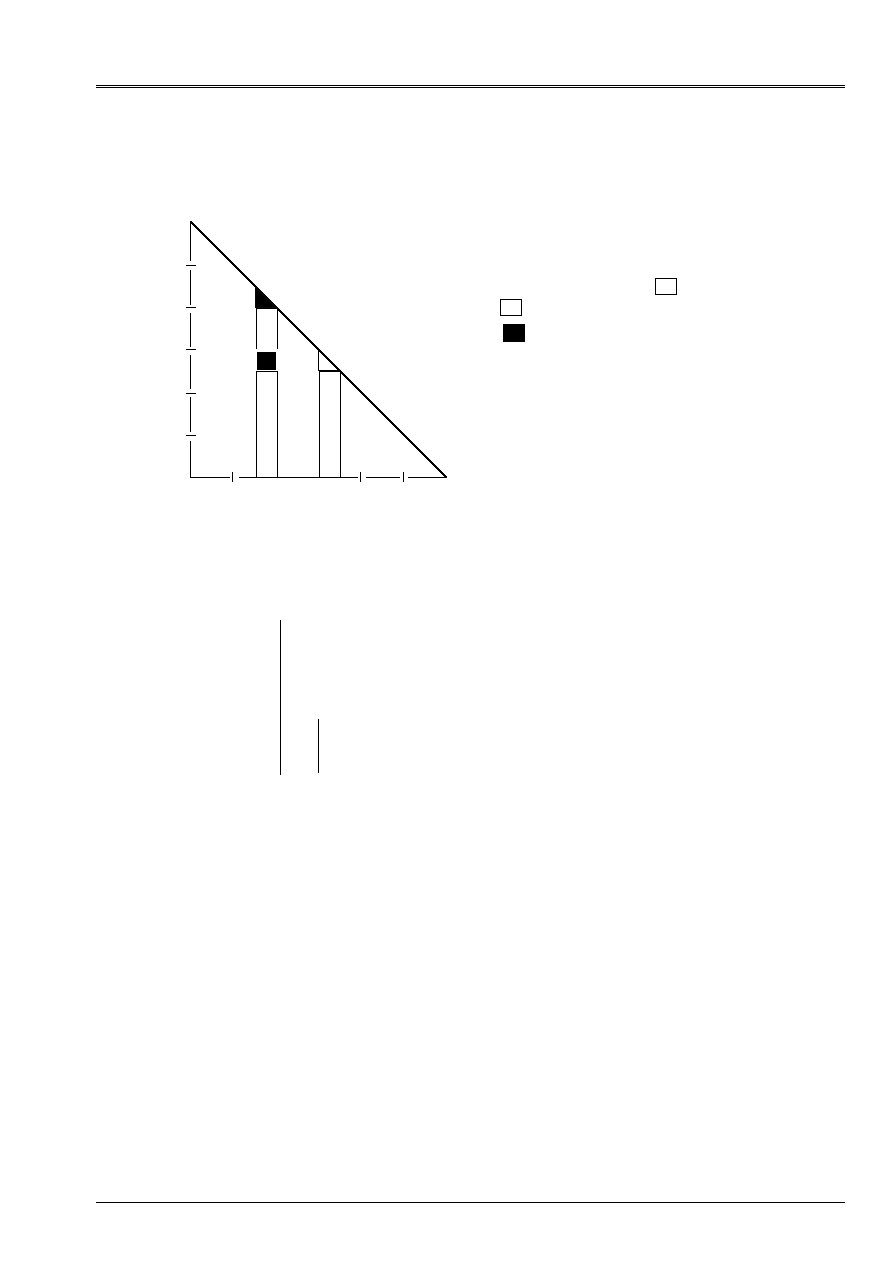
Code_Aster
®
Version
5.0
Titrate:
Method multifrontale
Date:
26/02/01
Author (S):
C. ROSE
Key:
R6.02.02-B
Page:
5/18
Manual of Reference
R6.06 booklet: Direct methods
HI-75/01/001/A
Method by columns
Let us examine the figure [Figure 1.1-b] following:
J
I
One adds to the column in
the column
in
, multiplied by the product of the terms
in
J
I
Appear 1.1-b
Let us suppose that the column
J
, i.e. terms
D
jj
and
(
)
L
ij
I
J
N
,
= +
1
, is known and
let us carry out the following algorithm:
(
)
for
to make
éq 1.1 - 7
for
to make
éq 1.1 - 8
= +,
,
saxpy
I
J
N
K
I
N
II
II
ij
jj
ki
ki
kj
ij
jj
1
1
2
with
D
D
L D
with
L
L
L L D
=
-
= +
=
-
Let us make three note:
1) the operations [éq 1.1-7] are called the elimination of the unknown factor
J
. Indeed, after [éq 1.1-7],
one will make call under the column never again
J
in the continuation of the algorithm.
method by column is sometimes qualified of “looking forward method”; as soon as they are
calculated, the terms of the matrix act on the following terms. On the other hand, them
methods by line are called “looking backward methods”; one will seek the terms
previously calculated with each new calculation,
2) the operation [éq
1.1-7] is an operation of the type “saxpy”, one withdraws from the vector
(
)
L
ki
K
I
N
,
= +
1
, the product of the constant
L
D
ij
jj
and of the vector
(
)
L
kj
K
I
N
,
= +
1
,
3) having carried out [éq 1.1-7] for
J
fixed, let us see what it remains to do to know the column
()
J
+
1
,
-
D
J
J
+ +
1
1
,
is known (it easily is checked),
-
it is enough to divide the column
(
)
L
K J
K
J
N
,
,
+
= +
1
2
by
D
J
J
+ +
1
1
,
to have the value
final of the aforementioned.

Code_Aster
®
Version
5.0
Titrate:
Method multifrontale
Date:
26/02/01
Author (S):
C. ROSE
Key:
R6.02.02-B
Page:
6/18
Manual of Reference
R6.06 booklet: Direct methods
HI-75/01/001/A
(The terms above were wrongly confused
L
ki
final and their name of programming which
contains the values of
L
ki
modified during eliminations).
One thus deduces the general algorithm from it from factorization
LDL
T
by columns.
for
to make
to make
for
to make
for
to make
= +,
/
/
,
/
/
,
for
,
/standardization/
elimination
saxpy
J
N
K
J
N
I
J
N
K
I
N
kj
kj
J
II
II
ij
jj
ki
ki
kj
ij
jj
J
=
= +
=
-
= +
=
-
=
1
1
1
1
2
with
with
L
L
D
with
D
D
L D
with
L
L
L L D
/
éq 1.1-9
Before passing to the concept of filling, it is advisable to make as of now a useful remark for
the continuation. If one looks at [éq 1.1-9], it appears that one can eliminate the unknown factor
J
, even if terms
(
)
L
ki
K
I
N
,
= +
1
and
D
II
are not yet available. Indeed, it is enough to preserve the terms
(
)
-
L L D
kj
ij
jj
, and to then add them under the terms
L
ki
. These terms
(
)
L L D
kj
ij
jj
,
I
varying
J
+
1
with
N
and
K
of
I
+
1
with
N
form a matrix associated with elimination with the unknown factor
J
, that one
will call thereafter the frontal matrix
J
.
1.2
Hollow matrix and filling
It is reminded the meeting that if the initial matrix comprises null terms, successive eliminations
cause filling, i.e. certain terms
L
ki
are different from zero whereas it
initial term
With
ki
is.
Let us suppose that before the elimination of the unknown factor
J
, the term
L
ki
is null; if
L
kj
and
L
ij
are both
nonnull, [éq 1.1-9] shows that
L
ki
also not no one will become him. This filling has an interpretation
graph. Let us suppose in this case that all the unknown factors are represented by the nodes of one
graph: the nodes will be connected
K
and
I
if and only if the term
With
ki
matrix initial is nonnull.
If
With
ki
is null with
I
connected to
J
and
K
connected to
J
, the elimination from the graphic point of view of
J
will consist in connecting then
I
and
K
.
The figure [Figure 1.2-a] illustrates this interpretation. The edges in dotted line are those create by
the elimination of
J
. They correspond in the new nonnull terms of the matrix
L
.
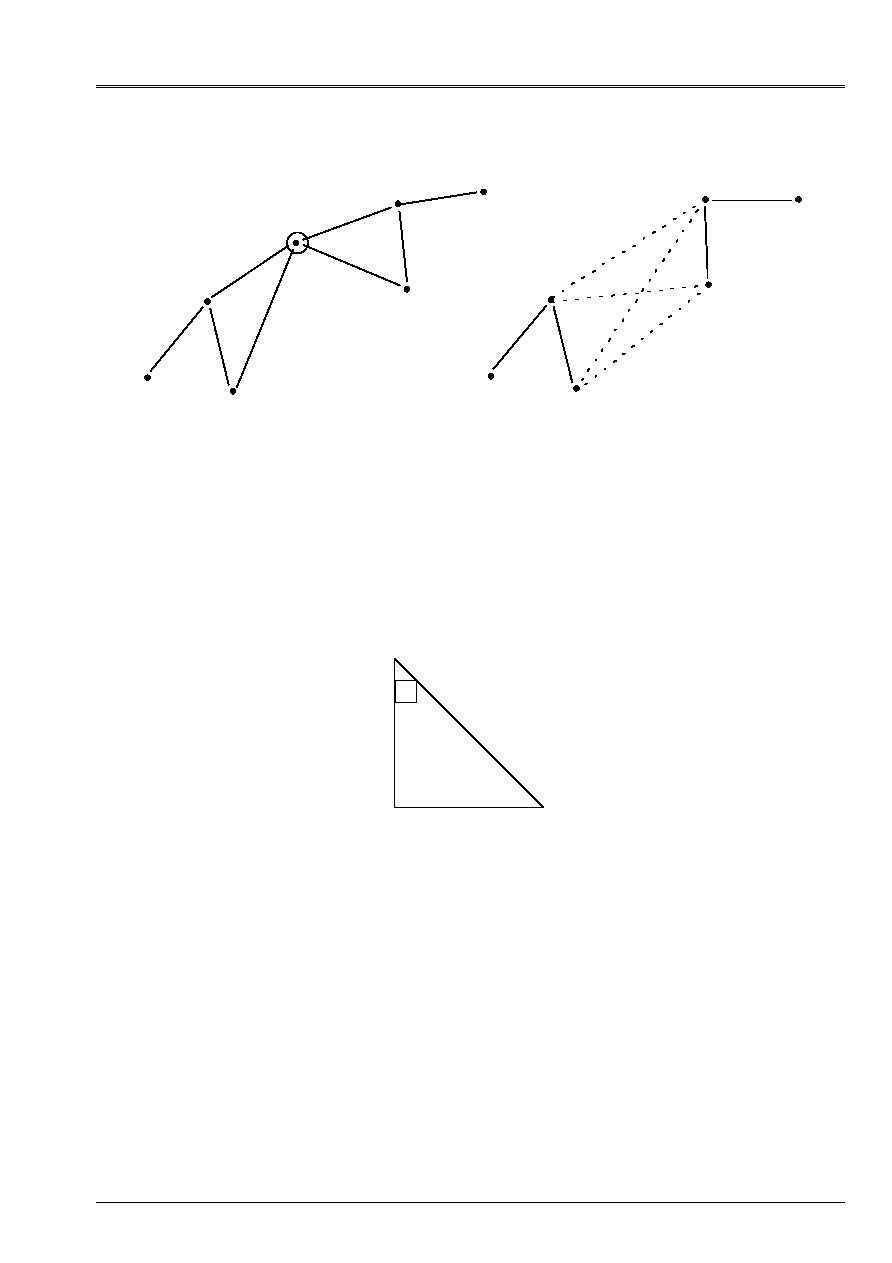
Code_Aster
®
Version
5.0
Titrate:
Method multifrontale
Date:
26/02/01
Author (S):
C. ROSE
Key:
R6.02.02-B
Page:
7/18
Manual of Reference
R6.06 booklet: Direct methods
HI-75/01/001/A
I
J
N
m
p
L
K
p
L
K
N
I
m
Appear 1.2-a: the elimination of the node J connects all its neighbors between them
1.3 Method
multifrontale
The method multifrontale is a direct method, of Gauss type, which aims at exploiting to the maximum it
hollow of the matrix to be factorized. It seeks, on the one hand, to minimize the filling by using one
optimal renumerotation, in addition, it extracts from the structure digs matrix information him
allowing to eliminate (cf page 5 notices (1)) unknown factors independently from/to each other.
Let us examine the simple case of the figure [Figure 1.3-a], where the matrix has only one null term,
With
21
.
Appear 1.3-a
Column 2 of
L
does not undergo the effects of the elimination of unknown factor 1, because the coefficient
With
L
21
21
0
0
=
=
,
then
(cf [éq 1.1-9] seen previously). Contributions to columns 3 and 4 of
L
, of unknown factors 1 and 2 are independent of their kind of elimination (it is necessary to look in detail
[éq 1.1-9]). Of this observation, one can introduce the concept of shaft of elimination presented by I. Duff
[bib1].

Code_Aster
®
Version
5.0
Titrate:
Method multifrontale
Date:
26/02/01
Author (S):
C. ROSE
Key:
R6.02.02-B
Page:
8/18
Manual of Reference
R6.06 booklet: Direct methods
HI-75/01/001/A
The shaft of elimination of the matrix
With
can be represented by the figure [Figure 1.3-b].
1
2
3
4
Appear 1.3-b
This tree structure contains two concepts:
·
the independence of certain eliminations (here variables 1 and 2), which will lead to one
possible parallelism of the operations,
·
the minimization of the operations to be carried out, (one sees on the tree structure that the term
L
21
is not
not to calculate).
Being given a hollow matrix, which one knows the filling, the shaft of elimination can be
built as follows:
·
all the sheets of the shaft (lower ends) correspond to the unknown factors
J
, such
that
With
ji
=
0
for
I
=
1
with
J
-
1
. Here 1 is of course a sheet because there is no term
With
1i
for
I
<
1
, 2 is also a sheet bus
With
21
0
=
,
·
one
node
J
has as a father
I
, if
I
is the smallest number of line such as
With
ij
0
. Here, 3 is
the father of 1 and 2.
Note:
1) one employs starting from now the vocabulary of the shaft, graph theory, sheet,
node… Here the shaft is turned over, its sheets are in bottom,
2) one will refer to [bib1] for more details and the demonstrations of the validity of the method,
3) in the example above, the command of elimination between the unknown factors (3) and (4) is fixed by
initial classification, one could have permuted the lines and the columns of the matrix and to have 4
like father of 1 and 2,
4) it should be noticed that the manufacture of this tree structure must take into account the terms
nonnull obtained by filling during elimination. (One will see more details on it
subject in [bib2]). One cannot manufacture the shaft of elimination only starting from the matrix
dig initial: it is necessary to also know the terms of filling like already mentioned
previously. The numerical factorization of the method multifrontale is preceded by one
important phase: the simulation of eliminations and thus, the creation of the nonnull terms.
One calls also this simulation, logical elimination or symbolic system. This simulation takes place
during the first phase: the renumerotation. One will see the four phases of
method multifrontale, most important being the first and the fourth.
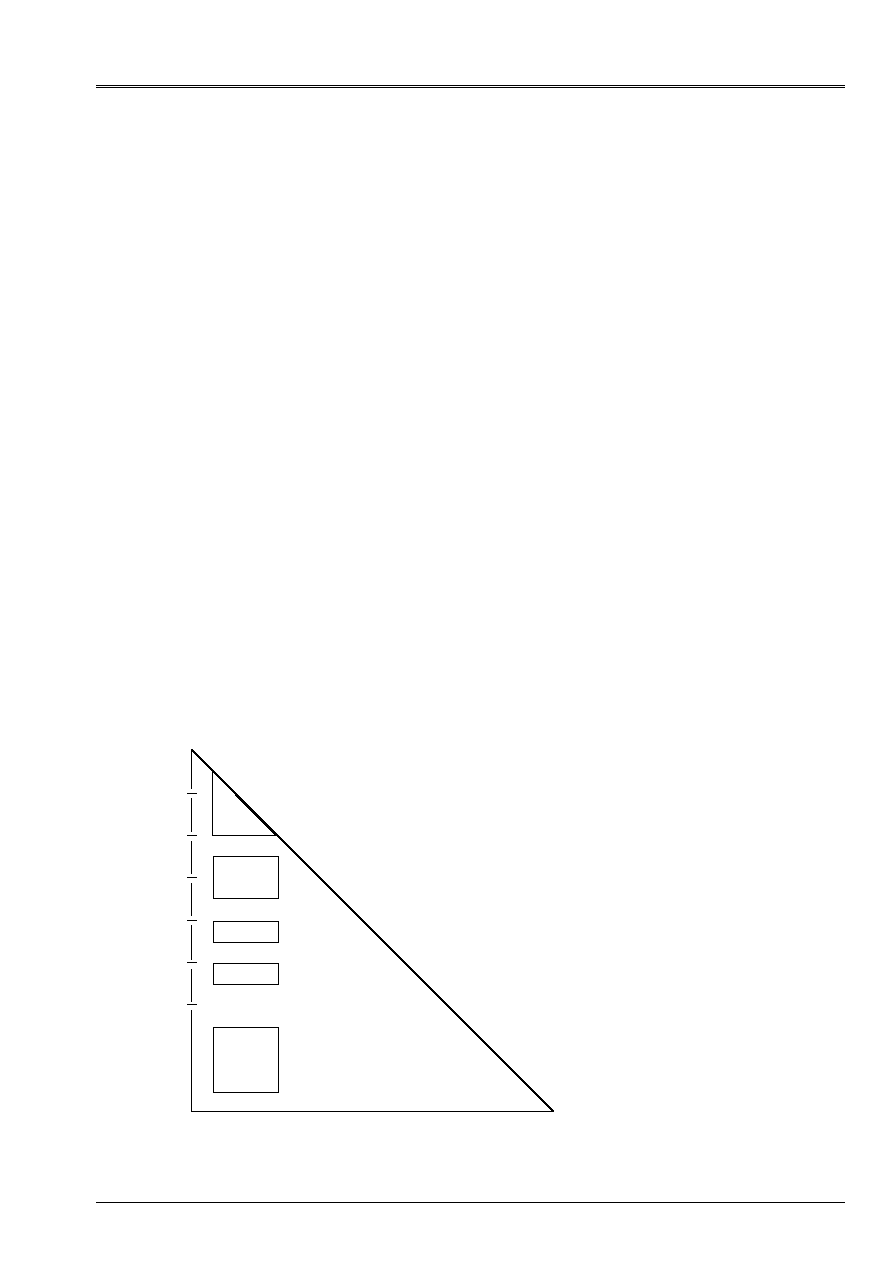
Code_Aster
®
Version
5.0
Titrate:
Method multifrontale
Date:
26/02/01
Author (S):
C. ROSE
Key:
R6.02.02-B
Page:
9/18
Manual of Reference
R6.06 booklet: Direct methods
HI-75/01/001/A
First phase: The renumerotation of the “minimum dismantles” (minimum degree).
The purpose of this renumerotation is first to minimize the number of operations to be carried out at the time of
factorization. For that one simulates the elimination of the nodes and one chooses like candidate for
elimination the node of the graph having the lowest number of neighbors. One uses the concept here of
graph seen with the figure [Figure 1.2-a]. The initial hollow matrix defines the graph on which one
work. This last is then updated to each elimination of nodes (creation of links).
simulation of the filling makes it possible to achieve the second goal which is the manufacture of the shaft
of elimination seen in the preceding paragraph. The third goal reached, is the creation of
super-nodes. It is an important concept that we will develop.
A super-node (SN) is formed of the whole of the nodes which, during elimination, have them
same neighbors within the meaning of the graph of elimination. During the simulation of elimination, one
detect that for example, the nodes
I
,
J
and
K
are:
·
of a share, neighbors between them (terms
L
ij
,
L
jk
,
L
ik
… are nonnull),
·
in addition, they have as common neighbors the nodes:
{
}
L m p Q R S T
,
(see
[Figure 1.3-c]).
They form the super-node then
{
}
I J K
,
and will be eliminated all together during factorization
numerical.
MF is a method of factorization per blocks, when it uses the concept of “super-node”.
This concept has the double following advantage:
·
it reduces the cost (considerable) of the renumerotation,
·
it reduces the cost of factorization by gathering calculations (use of routines
of linear algebra of type
blas-2
or
blas-3
).
One sees on [Figure 1.3-c] the structure of the columns
{
}
I J K
,
(nonnull terms in grayed) in one
virtual hollow total matrix. In fact, such a hollow matrix is never assembled. One
work in full local matrices which one calls the frontal matrices. There is one
frontal matrix by SN (One will re-examine this concept in the paragraph “numerical Factorization”).
T
S
R
Q
p
m
L
K
J
I
in grayed, nonnull terms of
total virtual matrix
Appear 1.3-c

Code_Aster
®
Version
5.0
Titrate:
Method multifrontale
Date:
26/02/01
Author (S):
C. ROSE
Key:
R6.02.02-B
Page:
10/18
Manual of Reference
R6.06 booklet: Direct methods
HI-75/01/001/A
In short, the first phase of the method multifrontale (the renumerotation by the “minimum dismantles”)
consist of the three following actions:
·
a renumerotation of the unknown factors to be eliminated, in order to minimize the filling. They are simulated
eliminations by updating each time the lists of neighbors of the nodes,
·
jointly with the preceding action, one builds the shaft of elimination, and,
·
one detects the “super-nodes”, which one can describe as class of equivalence for the relation
“the same neighbors have”.
Note:
The shaft of elimination provided by the renumerotation is expressed in terms of super-nodes, bus
numerical elimination to follow will be done by super-nodes.
Second phase: Factorization symbolic system
This phase is not as fundamental as the preceding one. It is an intended technical phase
to build certain pointers. They are in particular the tables of total indices and buildings which
the correspondences between the unknown factors during the assembly of the frontal matrices establish.
Third phase: The sequence of execution
It is also a technical phase. One saw in the preceding paragraph that the method consisted with
to traverse the shaft of elimination, by carrying out an elimination with each node of the shaft. The result
of this elimination is a frontal matrix. The command of this matrix is the number of neighbors of
Eliminated SN. The storage of the frontal matrices is expensive in occupation of the memory.
The frontal matrix
J
(result of the elimination of
SNj
) will be assembled in the frontal matrix
node
I
, where
I
is the father of
J
. One will see this phase more in detail during factorization
numerical). All the frontal matrices must be preserved, until they are
used during the elimination of “SN father”. One can then arrange the matrix of “SN father” in the place
those of “SN wire”.
There are several ways of traversing the shaft by respecting the stress: “the son must be eliminated front
the father ". The object of the third phase is to find the command of course which minimizes the place in
memory necessary for the arrangement of the frontal matrices ([bib2], page 2.12).
Fourth phase: Numerical factorization
This phase is effective factorization, i.e. the calculation of the matrices
L
and
D
. Thereafter,
one will confuse these two matrices and from a data-processing point of view
D
will be seen like the terms
diagonal of
L
.
Numerical factorization consists in traversing the shaft of elimination; for each “Super-node”,
one carries out:
·
assembly, in the frontal matrix “mother”, of the frontal matrices “girl”,
·
the elimination of the columns of the super-node.
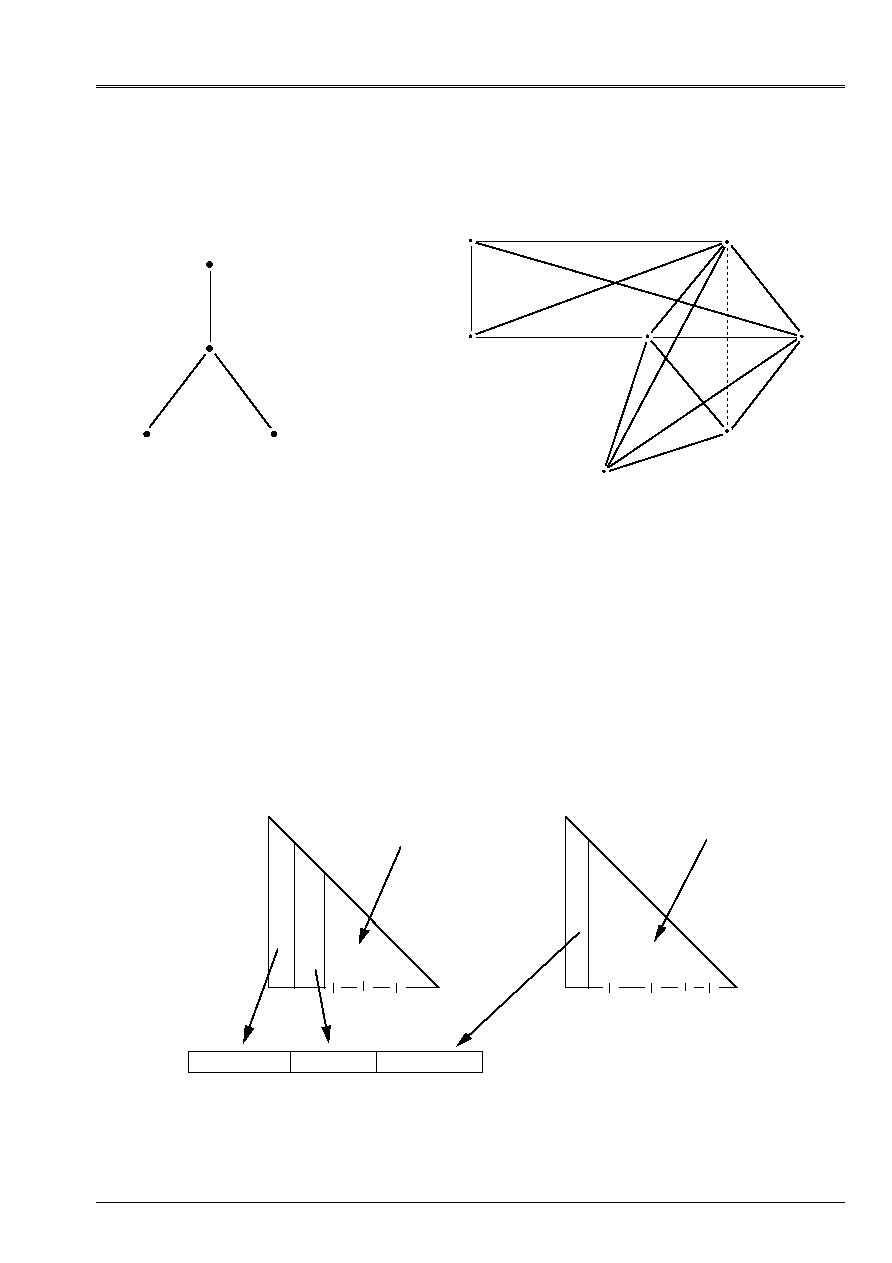
Code_Aster
®
Version
5.0
Titrate:
Method multifrontale
Date:
26/02/01
Author (S):
C. ROSE
Key:
R6.02.02-B
Page:
11/18
Manual of Reference
R6.06 booklet: Direct methods
HI-75/01/001/A
Let us see the following example with the graph and the shaft of elimination of [Figure 1.3-d] (nodes 8,9,
10 are not reproduced on the drawing).
1
2
3
4
5
6
7
SN4 (8,9,10)
SN3 (4,5,6,7)
SN2 (3)
SN1 (1,2)
Appear 1.3-d: Example of graph and shaft of elimination
Between brackets, one reads the numbers of the unknown factors of SN.
The elimination of the SN1 consists of:
1) assembly of columns 1 and 2 of the matrix initial, in a matrix of work, known as
frontal matrix before elimination. This matrix is of command 5, related to the unknown factors (1, 2, 4, 5,
6). (Because 1 and 2 is related to (4, 5, 6) only),
2) the elimination of the SN1 (of columns 1 and 2, according to the formulas [éq 1.1-7] and [éq 1.1-8] seen
previously),
3) arrangement of two columns 1 and 2 of the matrix, in a table Factor, which contains
columns of the total factorized matrix,
4) arrangement of the frontal matrix 1 of command 3 related to the unknown factors (4, 5, 6).
One makes the same thing with the SN2.
These two eliminations are illustrated by the figure [Figure 1.3-e], where one sees in grayed with hatching them
two frontal matrices.
1
2
4
5
6
3
4
5
6
7
frontal matrix 1
frontal matrix 2
table Factor
Appear 1.3-e
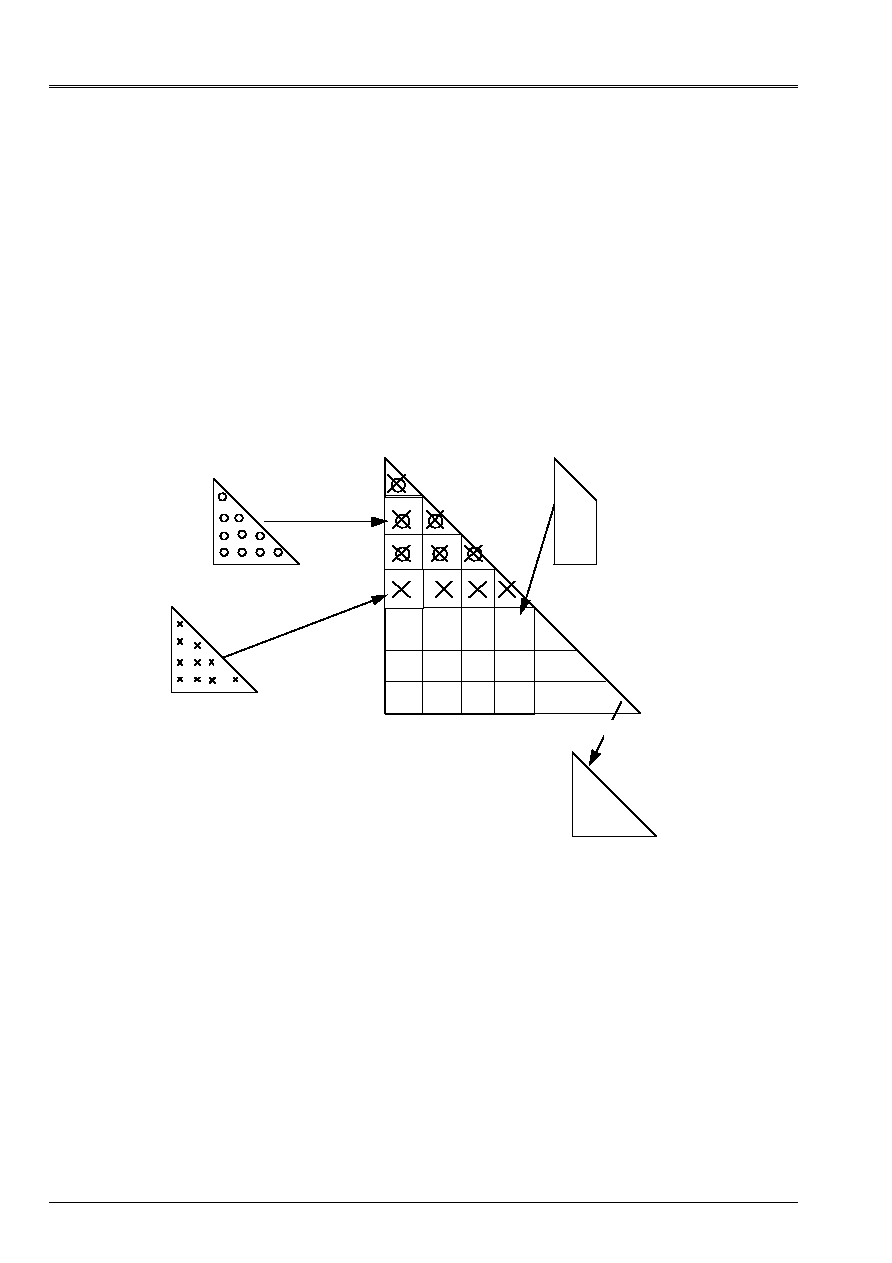
Code_Aster
®
Version
5.0
Titrate:
Method multifrontale
Date:
26/02/01
Author (S):
C. ROSE
Key:
R6.02.02-B
Page:
12/18
Manual of Reference
R6.06 booklet: Direct methods
HI-75/01/001/A
The elimination of the SN3 consists of:
·
the addition of the columns (4, 5, 6, 7) of the initial matrix, with the matrix of work of command 7, related to
unknown factors (4, 5, 6, 7, 8, 9, 10),
·
assembly of the frontal matrices 1 and 2 in this matrix of work,
·
the elimination of the columns (4, 5, 6, 7),
·
obtaining in additional Factor of four columns,
·
obtaining the frontal matrix 3d' command 3 (columns 8, 9, 10).
It is noticed that the frontal matrix 3 can line up in the place of the frontal matrices 1 and 2.
arrangement of these matrices requires a structure of pile where one piles up at the end of an elimination, and
where one depilates during the assembly. It is the maximum length of this pile which is minimized at the time of
the phase of sequence of execution.
The figure [Figure 1.3-f] illustrates the elimination of the SN3.
4
5
6
7
8
9
frontal matrix 1
stamp
frontal 2
frontal matrix 3
initial columns
10
Appear 1.3-f: Elimination of the SN3
It is noticed that the coefficient
L
74
(white square on the figure [Figure 1.3-f]), comes from elimination
SN3, and that the initial term
With
74
is null (link in dotted on the figure [Figure 1.3-d].
One saw in paragraph 1.1 that the elimination of a column consisted of an operation of the type “saxpy”,
addition with a vector of the product of a vector by a scalar.
It is seen easily that the elimination of a super-node, groups columns, consists of an operation
of type “matrix-vector produces”. These operations consume the greatest part in calculating times,
work of factorization of the matrix. They are carried out by subroutines of
library BLAS, provided after being optimized on the majority of the computers. One sees on
appear [Figure 1.3-g] the column
J
update by the product of the matrix
[
]
With J
N
m
+
1
1
: :
and of
vector
[
]
With J
m
:
1
.
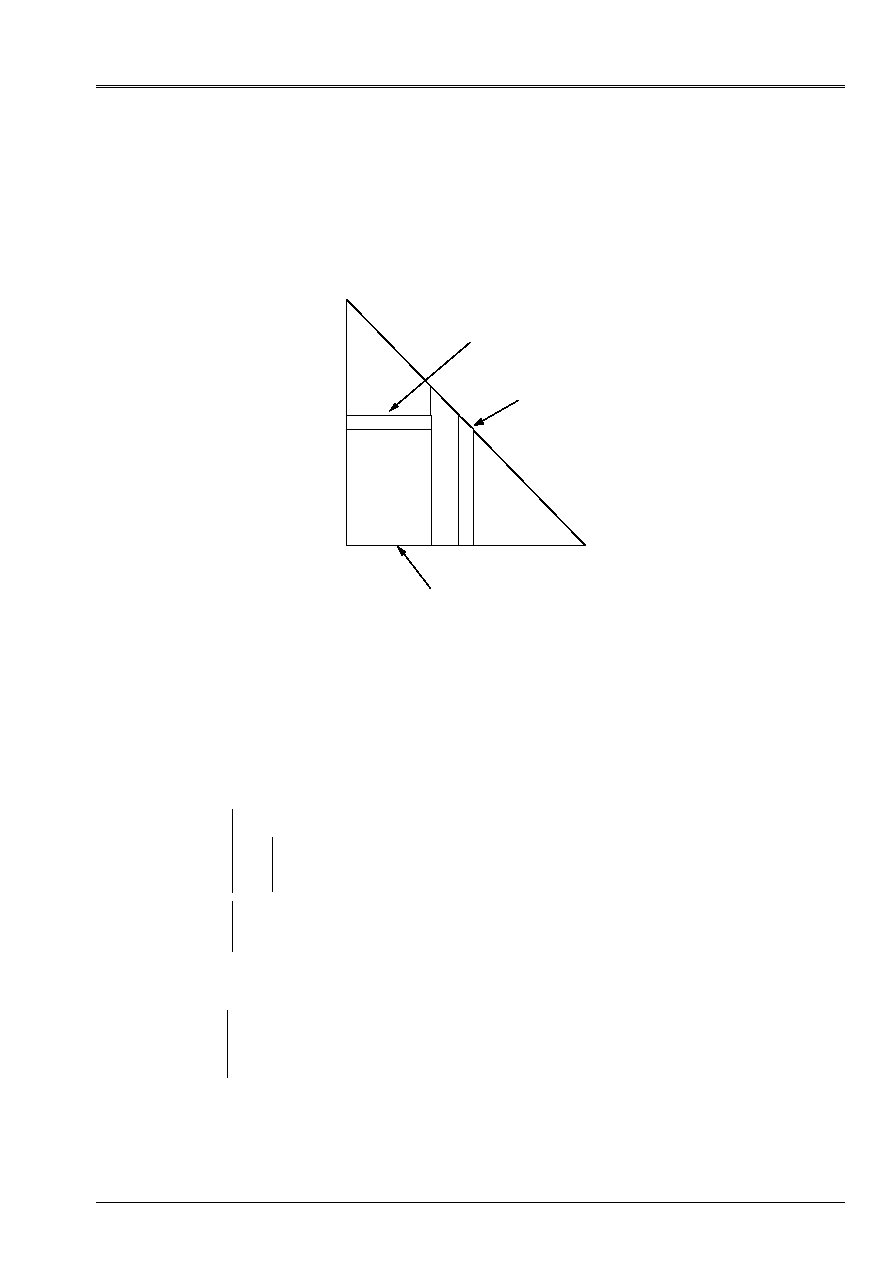
Code_Aster
®
Version
5.0
Titrate:
Method multifrontale
Date:
26/02/01
Author (S):
C. ROSE
Key:
R6.02.02-B
Page:
13/18
Manual of Reference
R6.06 booklet: Direct methods
HI-75/01/001/A
Factorization being finished, one has the matrix factorized in the shape of a table
compacted nonnull terms only. It is a storage of the type “Morse”. The table of index
total evoked in factorization symbolic system indicates, for each column of
L
, numbers of
line of each stored coefficient.
m
N
J
L
L
I
J
m
+
p
To J, 1: m
[
]
With J
+
1: N, J
[
]
With J
+
1: N, 1: m
[
]
Appear 1.3-g: Update of the column J by a product stamps * vector
1.4
Descent - Increase
Columns of
L
being stored in a compacted way, the descent is of type “saxpy” and
increase of the type produces scalar, these two operations being both indexed. I.e.
the algorithm of descent is coarsely the following, (while having initialized beforehand
X
by
second member of the system):
()
(
)
()
(
)
()
()
()
(saxpy indexed)
for
with
to make
for
to make
for
with
to make
I
N
K
total K
total K
I
I
N
I
I
I
ki
II
=
=
-
×
=
=
1
1
/
column
X
X
L
X
X
X
D
The increase, it, is written in the form:
()
()
()
(
)
N 1
indexed scalar product
for
varying
to make
I
I
I
total K
ki
K column I
of with
:
X
X
L
X
=
-

Code_Aster
®
Version
5.0
Titrate:
Method multifrontale
Date:
26/02/01
Author (S):
C. ROSE
Key:
R6.02.02-B
Page:
14/18
Manual of Reference
R6.06 booklet: Direct methods
HI-75/01/001/A
2
Establishment and use in Code_Aster
The use of the multi-frontal method is accessible by the operator
NUME_DDL,
way
following:
naked =
NUME_DDL (matr_rigi: matr, storage: “MORSE”, or renum: “MDA”
renum: “MANDELEVIUM”); or renum: “MONGREL”
Two other methods of renumerotation are available: Approximate Degré minimum (MDA), which is
an alternative of the method of the degree minimum, and a method of encased dissection (MONGREL). They
are briefly described in appendices 1 and 2. It is enough to replace the value of renum by MDA, or
MONGREL.
This method is also available in
MECA_STATIQUE
,
STAT_NON_LINE
,
DYNA_NON_LINE
,
THER_LINEAIRE
,
THER_NON_LINE
with same logic.
Then, the operator will be used
FACT_LDLT
, the call being the same one as in the case of a matrix
stored according to the profile mode.
In
NUME_DDL
, it is indicated that the matrix to be factorized is arranged according to the mode
“MORSE”
and that
one asks for one of the two renumérotations of the “minimum dismantles”, or a renumerotation by
encased dissection (MONGREL).
In this case,
NUME_DDL
carry out the first three phases seen previously:
1) renumerotation,
2) factorization
symbolic system,
3) sequence
of execution.
These operations take into account the presence of “double-lagrange” and respect the command of D.D.L.
implied by the boundary conditions.
Moreover,
NUME_DDL
prepare cutting per blocks of the factorized matrix. Indeed, one saw that with
each elimination, one arranged in a table the columns of the factorized matrix. These columns
will be useful that at the time of the gone up descent/. They are never used for calculation of other columns. There is not
thus no interest to have them all in memory. They are arranged, in Code_Aster, under
form of a collection of objects JEVEUX length variable. These objects, blocks of columns, must
nevertheless to satisfy the following stress: each block corresponds to an integer of
“supernoeuds”. One cannot thus have the columns of same “a supernoeud” on several blocks.
Since one does not know the place in memory available during numerical factorization,
one decides in
NUME_DDL
that the maximum length of each block will be the max. one (on all SN)
sum lengths of the columns of SN.
(
)
(
)
Lb
Max
length neck
SNi
K SNi
K
max
.
=
, in summary

Code_Aster
®
Version
5.0
Titrate:
Method multifrontale
Date:
26/02/01
Author (S):
C. ROSE
Key:
R6.02.02-B
Page:
15/18
Manual of Reference
R6.06 booklet: Direct methods
HI-75/01/001/A
The operator
FACT_LDLT
use the pointers created by
NUME_DDL
and the initial matrix '
MORSE'
. It
create the matrix factorized in the shape of a collection of objects JEVEUX, as one saw
previously. A structure of data provisional is also necessary. It relates to the matrices
frontal. Two cases arise:
·
the pile of the frontal matrices can hold very whole in memory (in a table
monodimensional), in this case, one allocates an object JEVEUX and the algorithm multifrontal manages
then itself this space, by arranging the frontal matrix “mother” in the place of the matrices
“girls”,
·
it does not hold and, in this case, it is created in the shape of a collection of objects
JEVEUX, each frontal matrix being an object. For the elimination of the “supernoeud”
I
, it is necessary
at the same time in memory:
-
the block of factorized to which belongs it
SNi
,
-
the object stamps frontal
I
, like all the frontal matrices “girl” of
I
, which
will be destroyed after their use.
The frontal matrix
I
, it, will be stored until its use and its destruction. One
could, as it was made before, to release within the meaning of JEVEUX each frontal matrix after its
creation. That can involve then, in the event of weak memory available, a storage on disc
crippling in volume. Indeed, a destruction of object JEVEUX does not involve the destruction of sound
image on disc, and summons it lengths of the frontal matrices is enormous.
In short, it is necessary to be able to arrange simultaneously in memory:
·
a block of factorized,
·
the pile of the frontal matrices, in only one object if that holds, several objects if not.
One thus needs “sufficient” memory to use the method multifrontale. Second manner of
to arrange the pile allows the execution when the memory is sufficient, but émiettée.
When the memory is insufficient, it is necessary to start again the execution of
fact_ldlt
with a memory more
large.
Note:
In order to provide an order of magnitude, the large case-tests treated by Code_Aster, required
up to 20 or 25 megawords of memory for the pile of the frontal matrices. In the majority of
case the fact_ldlt resolution is used after many other operators, and does not profit any more
that of a émiéttée memory, or little of memory, (in particular during the use of
the operator
MODE_ITER_SIMULT
or
MODE_ITER_INV
, which allocates much place to the vectors
LANCZOS). The user wanting to carry out a very large case can have interest to proceed into two
stages, the second executant fact_ldlt in mode “continuation” and profiting then from a memory
not émiettée power station.

Code_Aster
®
Version
5.0
Titrate:
Method multifrontale
Date:
26/02/01
Author (S):
C. ROSE
Key:
R6.02.02-B
Page:
16/18
Manual of Reference
R6.06 booklet: Direct methods
HI-75/01/001/A
3 Bibliography
[1]
I. DUFF: Parallel implementation off multifrontal design ". Parallel computing 3, pp. 193-201
(1986)
[2]
C. ROSE: A method multifrontale for the direct resolution of the linear systems. Note
HI-76/93/008
[3]
Minimum year approximate dismantles ordering algorithm, Tim DAVIS, Patrick AMESTOY, Iain
DUFF, Technical Carryforward TR 94-039, (SIAM J. Matrix Analysis & Applications, flight 17, no.4,
(1996), pp. 886-905).
[4]
Minimum The evolution off the dismantles ordering ordering, A. George, J. Liu, SIAM review, flight 31
1989. One can also consult Internet sites following
: HTTP
://www.cerfacs.fr -
HTTP://ww.cise.ufl.edu/~davis
[5]
MONGREL: With software package for partitionning unstructured graphs, partitioning meshes, and
computing yarn oredering off sparse matrices Version 4.0. George Karypis &Vipin KUMAR
[6]
With fast and high quality MultiLevel Design for partitioning irregular graphs. SIAM newspaper one
Scientific Computing 1998, Flight 20 No 1. George Karypis & Vipin KUMAR

Code_Aster
®
Version
5.0
Titrate:
Method multifrontale
Date:
26/02/01
Author (S):
C. ROSE
Key:
R6.02.02-B
Page:
17/18
Manual of Reference
R6.06 booklet: Direct methods
HI-75/01/001/A
Appendix
1
Reference material of the method
“Approximate Minimum dismantles”
The algorithm of the “minimum dismantles” consists has to number the nodes of a graph in the ascending order of
numbers of their neighbor. Here is a simplified but essential description.
1) one forms the initial graph associated with the matrix digs to factorize,
2) one calculates the number of the neighbors of the nodes (their degree),
3) one numbers in first (then eliminates from the graph), the node having less neighbors (minimum degree),
4) one updates the graph of stage 1,
5) one turns over at stage 2.
The calculation of the degree of the nodes is an expensive operation in calculating times. The method “Approximate
Minimum dismantles “[bib3] proposes to reduce this cost. For that, instead of calculating the real degree of a node
one is satisfied with one raising (often equal, according to the authors, with the true degree), of easier calculation. Indeed with
run of elimination the true degree of the node
I
is equal to
D
I
, cardinal of the following unit:
{}
With
L
I
E
, where
the union is made on the whole of the neighbors
E
, previously eliminated, of
I
(terms of filling), and where
With
I
is the whole of the initial neighbors. In the approximate method
D
I
is replaced by
D
I
=
card (
With
I
) +
card
{}
L
E
, i.e. one neglects the intersection of
L
E
.
This method is described in [bib3] and the various alternatives of the algorithm of the “minimum dismantles” are
exposed in [bib4].
Appendix 2 Reference material Mongrel
The implementation of the module of renumerotation for matrices dig MONGREL is described in the note [bib5],
provided in the index mongrel-4.0/Doc. of the software. The algorithm used is described in [bib6]
It is also possible to consult following address Internet: HTTP://www.cs.umn.edu/~karypis
Mongrel is mainly a cutting tool of graphs (mesh), aiming at the 2 following goals:
·
to cut out a graph given out of p subgraphs having the closest possible sizes,
·
to minimize the size of the borders between the subgraphs.
The first goal aims at a good balance of parallelization on p processors and the second aims at minimizing
communications.
MONGREL uses an algorithm of partition of graphs on several levels, proceeding in the following way: with
each level one seeks separators (together of with dimensions), minimal sizes cutting the graph in
equal parts. MONGREL applies this principle to the renumerotation of the nodes of a graph while seeking to each
stage a separator dividing the graph into 2 subgraphs. The nodes of the first at the head are numbered
subgraph, then those of the second, then those of the separator. One applies then the same algorithm to the 2
under graphs in a recursive way.

Code_Aster
®
Version
5.0
Titrate:
Method multifrontale
Date:
26/02/01
Author (S):
C. ROSE
Key:
R6.02.02-B
Page:
18/18
Manual of Reference
R6.06 booklet: Direct methods
HI-75/01/001/A
Intentionally white left page.

















